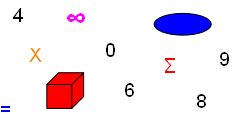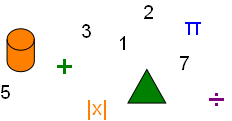



Subtracting Fractions
with Like and Unlike Denominators


Adding and subtracting fractions are closely related by their math rules. Their difference, subtraction math problems work with numbers having a minus sign. The result can be a negative number.
With like fractions the denominators are the same. With unlike fractions some or all of the denominators are different.
Subtracting Fractions with Like Denominators
Simply sum the numerators.
6/8 − 3/8 − 2/8 = (6/8 − 3/8) − 2/8 = 3/8 − 2/8 = 1/8
5/10 − 2/10 − 4/10 = (5/10 − 2/10) − 4/10 = 3/10 − 4/10 = −1/10
If subtracting mixed fractions convert them to improper fractions before summing the numerators:
1/4 − 1 3/4 = 1/4 − 7/4 = −6/4 = −3/2 = −1 1/2
Adding and subtracting fractions together:
1 1/5 − 4/5 + 2/5 − 3/5 = (6/5 − 4/5) + 2/5 − 3/5 = (2/5 + 2/5) − 3/5 = 4/5 − 3/5 = 1/5
As a last step always reduce fractions, assure they are proper fractions and check the answer is correct.

Two quarter equal one half.
How to Subtract Fractions with Unlike Denominators
1) Convert mixed fractions to improper fractions (1 1/3 = 4/3).
2) Determine the least common multiple (LCM) for the different denominators
(All denominators must be the same to subtract fractions).
3) Next, the numerator values are evaluated so they remain equivalent fractions.
Check all fractions to be subtracted and convert mixed fractions to improper fractions.
The least common multiple is the smallest positive integer that is divisible by all denominators (LCM is also known as lowest common multiple and least common denominator).
Let’s solve the following fraction subtraction problem:
6/16 − 1 1/3 − 1/2 =
Always reduce fractions.
3/8 − 1 1/3 − 1/2 =
If subtracting mixed fractions convert them to improper fractions.
3/8 − 4/3 − 1/2 =
The least common multiple is 24, the smallest positive integer that all denominators divide so the result is a whole number.
Next make each fraction equivalent by adjusting the numerator using 24 as the denominator. The numerator must be multiplied by the same number that the denominator is multiplied to remain an equivalent fraction.
For 3/8 the denominator 8 must be multiplied by 3 to equal 24, the numerator must also be multiplied by 3; 3/8 = 9/24
For 4/3 the denominator 3 must be multiplied by 8 to equal 24, the numerator must also be multiplied by 8; 4/3 = 32/24
For 1/2 the denominator 2 must be multiplied by 12 to equal 24, the numerator must be multiplied by 12; 1/2 = 12/24
3/8 − 4/3 − 1/2 =
9/24 − 32/24 − 12/24 =
(9/24 − 32/24) − 12/24 =
(−23/24) − 12/24 =
−35/24 = −1 11/24
As a last step always reduce fractions, assure they are proper fractions and check the answer is correct.
Finding the lowest common denominator is sometimes tricky.
From above our denominators are: 8, 3, 2
Since 8 is our largest denominator the LCM must be greater than or equal to 8.
Take 2 denominators and multiply them. Then check the remaining denominators for divisibility.
8 × 2 = 16, but 3 cannot equally divide 16.
8 × 3 = 24, and 24 is divisible equally by 2.
24 is the lowest common denominator.
If the lowest common multiple is not obvious all denominators can be multiplied together:
8 × 3 × 2 = 48
3/8 − 4/3 − 1/2 =
18/48 − 64/48 − 24/48 =
We see that each fraction can be reduced by dividing by 2:
18/48 − 64/48 − 24/48 =
9/24 − 32/24 − 12/24 =
−35/24
It is best to always state answers as simplified fractions: −35/24 = −1 11/24
Copyright © DigitMath.com
All Rights Reserved.